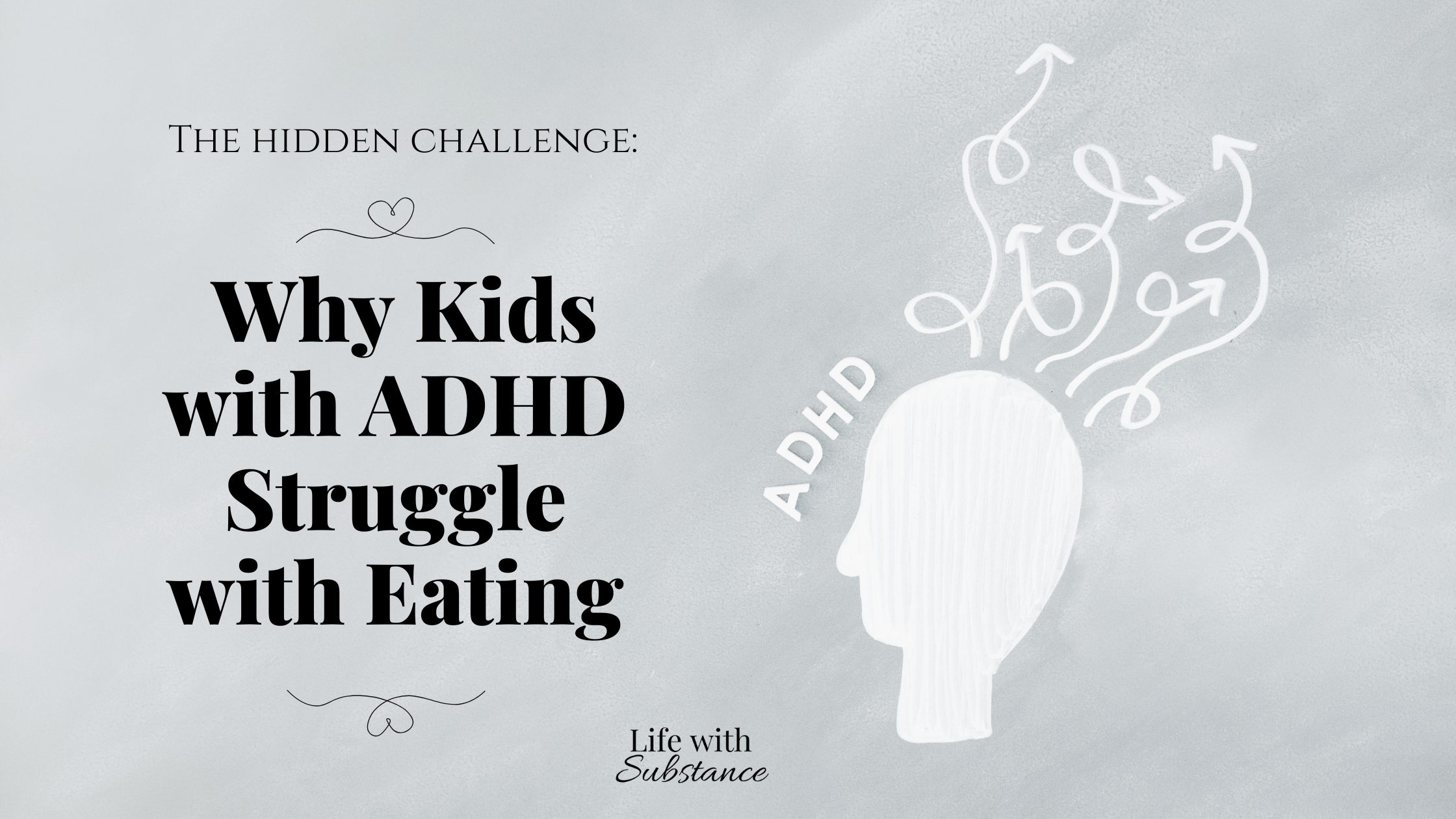This post may contain affiliate links. If you shop from one of our links, we may earn a commission.
Children with Attention-Deficit Hyperactivity Disorder (ADHD) often face a multitude of challenges in their daily lives. Symptoms of ADHD include struggles with focus and impulsivity to difficulties in social interactions. ADHD is a neurodevelopmental disorder that can impact various aspects of a child’s well-being. One often overlooked challenge is the issue of eating. In this blog post, we will discuss why kids with ADHD may struggle with eating and provide practical tips for parents to help navigate this complex issue.
- Understanding ADHD and Its Impact on Daily Life
- The Link Between ADHD Medications and Appetite
- How to Help Your Child Identify Hunger While on Medications
- Reasons Why Your Child with ADHD May Struggle to Eat
- The Battle with Impulsivity and Sitting Still
- Navigating the World of Distractibility During Meals
- Practical Tips for Easier Meal Times for Kids with ADHD
- What to do if Your Child is Underweight
- In Summary
Understanding ADHD and Its Impact on Daily Life
Navigating daily life with ADHD can present unique challenges that extend far beyond the classroom or playground. Children living with ADHD often find themselves wrestling with symptoms that disrupt their capacity to engage in everyday activities. The essence of ADHD lies in its trio of hallmark symptoms: inattention, hyperactivity, and impulsivity.
These core characteristics can significantly hinder a child’s ability to process information efficiently, remain seated during family meals, or even follow through with simple daily routines. What might seem like routine tasks to others can feel like insurmountable obstacles to a child with ADHD, affecting not just academic performance but also their social interactions and family dynamics.
Substance abuse disorders, depression, bipolar, anxiety disorders, depression, and oppositional defiant disorder are common psychiatric comorbidities associated with ADHD.
The journey of understanding and managing ADHD is multifaceted, touching every aspect of life. As parents of children with ADHD navigate this landscape, recognizing the pervasive impact it has on a child’s day-to-day existence is the first step towards fostering a supportive and nurturing environment that can help mitigate these challenges.
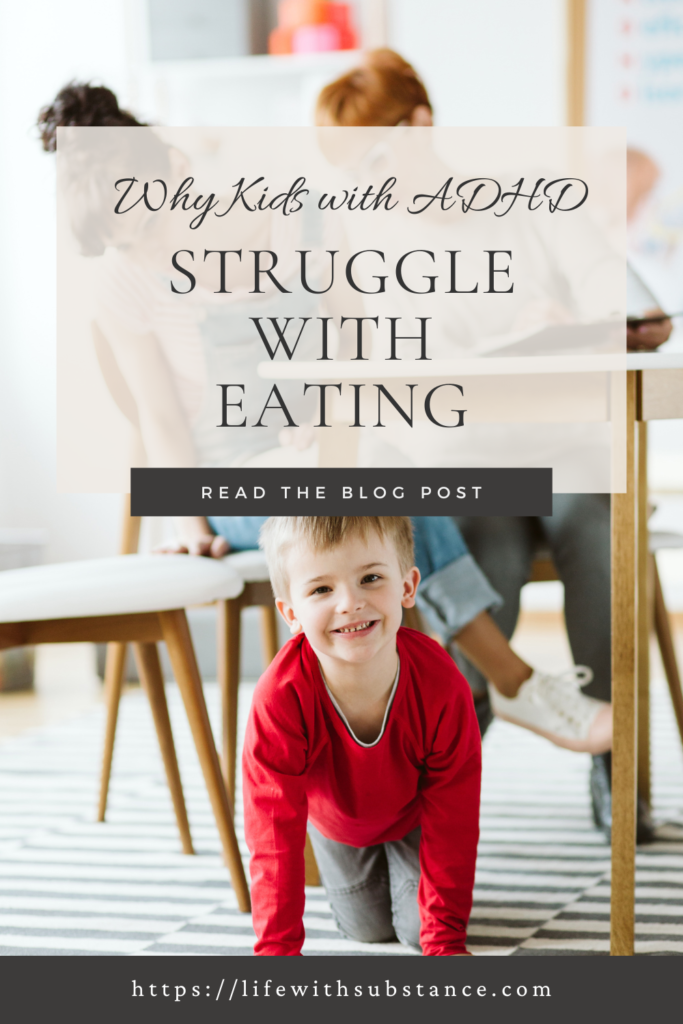
The Link Between ADHD Medications and Appetite
One intervention parents may choose for managing Attention Deficit Hyperactivity Disorder in children involves the use of medication designed to alleviate symptoms and enhance focus. A common side effect of stimulant medication is a loss of appetite. This side effect poses a significant challenge for ensuring that children receive adequate nutrition throughout their growth and developmental phases.
As stimulant medications can lead to a lessened desire to eat, children might skip meals or eat far less than what is required for their age and activity level. Sometimes parents view this as selective eating, however, decreased appetite is one of the side effects of their medication.
Research conducted on methylphenidate products such as Concerta, Ritalin, and Focalin has demonstrated that roughly thirty percent of children taking them encounter a decrease in appetite. Similarly, amphetamine products like Adderall and Vyvanse also lead to a decline in appetite. Additionally, almost forty percent of children who take ADHD medication experience abdominal discomfort, which can impact their ability to consume food.
Ensuring that the child’s nutritional needs are met and they still eat a balanced diet, despite the appetite suppression caused by ADHD medication, becomes an essential part of their overall care plan.

How to Help Your Child Identify Hunger While on Medications
When ADHD medications suppress appetite, it can be a real puzzle for kids to recognize when they’re truly hungry, and causes irregular eating habits. It’s our role as parents to guide them through this maze, making sure they’re nourished and energized for the day.
Furthermore, having open discussions about how their body feels and the importance of eating, even when they’re not feeling particularly hungry, can help children develop a better sense of their own nutritional needs. You can help your child understand that while their tummy may not feel hungry, other signs are telling them they may need to eat such as:
- Decreased energy levels
- Headache or brain fog due to low blood sugars
- Feeling grouchy or moody
Reasons Why Your Child with ADHD May Struggle to Eat
There are several reasons why kids with ADHD struggle to eat at meal times. Let’s break them down.

Sensory Overload at Meal Times
Meal times can transform into a battleground for children with ADHD, not just because of the food on their plate, but due to the sensory overload it may trigger. For young children, the array of textures, smells, and flavors that many of us enjoy can provoke intense discomfort or aversion. Embracing this understanding, parents can take proactive steps to ease the stress associated with eating.
Simplifying meals to include familiar and less sensory-intensive foods can make a big difference. Additionally, gradually introducing new foods in a non-pressured way can help desensitize their reactions over time.
Executive Function Difficulties
Navigating daily routines, including meals, can be a herculean task for children with ADHD due to challenges with executive functions. These functions are critical for planning what to eat, deciding when to eat, and even recognizing the feeling of hunger or fullness. Their impairment can disrupt a child’s ability to adhere to a structured mealtime routine or make choices that align with their nutritional needs. Here are some examples of execution functions that an ADHD child may struggle with.
Task initiation
A child with ADHD can have a difficult time with task initiation. For example, they may have a hard time stopping what they are currently doing to go grab a snack or meal.
Task execution
This relates to a child struggling to finish a task such as completing a meal, following a multi-step recipe, or forgetting to finish putting together their lunchbox.
Organization
Children with ADHD really benefit from having organizational systems in place to help them stay on track. Common scenarios that they may struggle with include: forgetting to bring their lunch or snack to school, losing track of where they placed their snack, or following a multi-step recipe.
Focus
Due to having a hard time staying focused, kids may have a hard time finishing a meal or snack, get easily distracted at school lunch and forget to eat, or want to talk or move around during a meal.
Time Blindness
This would relate to not allowing adequate time to eat a meal before moving to the next activity, not stopping playing to go get a snack, or underestimating the amount of time it takes to put together a lunchbox.
Working Memory
Examples of this include having to re-read a recipe multiple times, forgetting food in the oven or trying to remember the cook time.
Impulse Control
Kids struggling with impulsive behavior are likely to eat whatever is right in front of them rather than noticing other options around them or thinking about what foods may be more nourishing for their bodies. This can also lead to binge eating or disordered eating. Children with ADHD have a much higher chance of developing the most common eating disorders due to struggles with executive functions and their relationship with food.
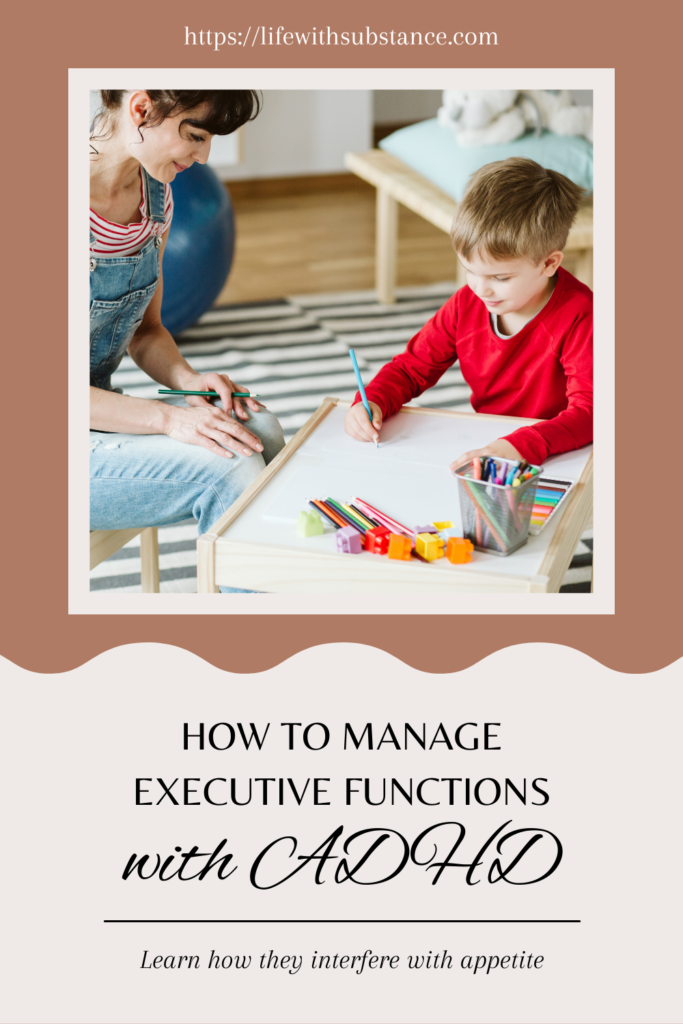
How to Help
To lend a hand, parents can implement clear and consistent routines around food. Creating visual meal planners or using apps designed to enhance organization can turn decision-making into a fun, engaging activity. Additionally, breaking down the process into smaller, manageable steps can help children better understand and follow through with eating routines. This might involve selecting recipes together, preparing the food, and setting the table, each step presented as a mini-goal.
Offering choices within a structured framework can also empower children with ADHD, giving them a sense of control while ensuring they are guided towards nutritious options. By doing this, we not only assist in developing their executive function skills but also in cultivating a relationship with food that is healthy, informed, and positive.
The Battle with Impulsivity and Sitting Still
For ADHD children, the act of remaining seated and eating a meal can feel like an uphill battle due to their impulsivity and difficulty sitting still. This can often lead to rushed meals where they may not fully chew or even fully taste their food, diminishing the overall mealtime experience. To counteract these tendencies, introducing mindfulness into eating practices can be a game-changer. Encouraging your child to take small bites and chew slowly can help them become more present during meal times.
Ways to help your child seated at the dinner table:
- Ensure appropriate seating
- Limit distractions at the table
- Make mealtimes engaging through food play or fun family discussions
- Allow self-serving
- Use visual cues, such as a timer as a gentle reminder to slow down and enjoy the meal
- Simple breathing exercises before starting the meal can also aid in calming their mind and preparing them for a more settled eating experience
By adopting these strategies, parents can help their children navigate the challenges of impulsivity and restlessness, making meal times a more enjoyable and nourishing part of their day.
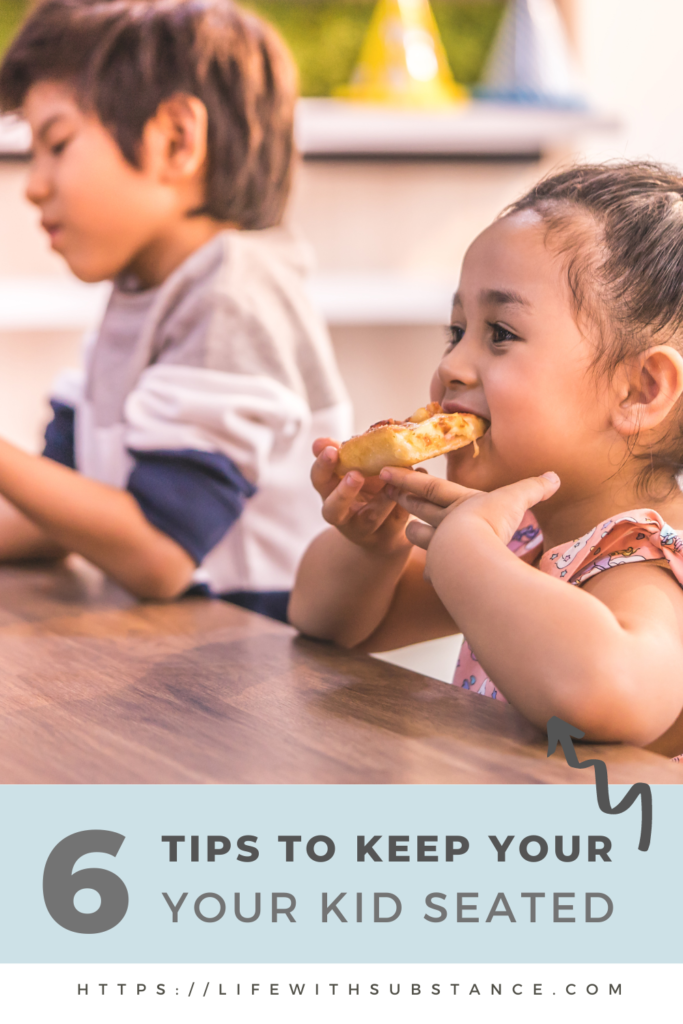
Navigating the World of Distractibility During Meals
In a world where distractions abound, meal times for children with ADHD can become particularly challenging. The pull of electronics, buzzing conversations, or the simple allure of playing with toys can derail their focus from the task at hand: eating. Establishing a distraction-free zone around the dining area can significantly aid in centering their attention on their meal.
This might involve turning off the TV, putting away mobile devices, and creating a calm ambiance that encourages mindful eating. You could also introduce engaging but non-distractive mealtime rituals, such as discussing the day’s highlights or what they’re looking forward to tomorrow, fostering an environment where the focus naturally gravitates towards the act of eating.
Incorporating tactile table settings, like textured placemats or utensils designed for easy grip, can also provide subtle sensory input that keeps them grounded and focused on their meal. Engaging them in conversation about the colors, textures, and flavors on their plate can further anchor their attention, transforming mealtime into an interactive experience that captivates their focus. Through these strategies, parents can help navigate the bustling world of distractibility, turning meal times into an oasis of calm and focus amidst the chaos.
Practical Tips for Easier Meal Times for Kids with ADHD
Previous research has shown a connection between ADHD and nutritional deficiencies. Navigating meal times with children who have ADHD can feel daunting, but it doesn’t have to be. By implementing a few simple strategies, you can create a more positive and engaging dining experience for your child.
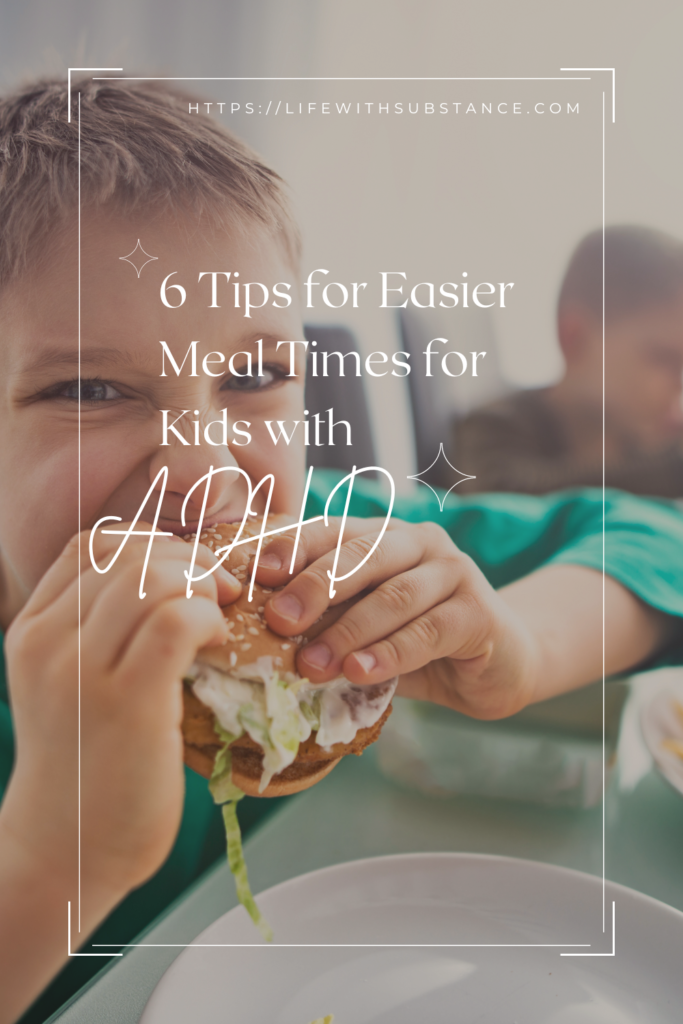
1. Establish a Routine
Establishing a routine for regular meals and snacks helps instill a sense of predictability and structure, crucial for kids with ADHD. This structure helps create a sense of normalcy around eating, even when natural hunger cues might be absent. During these scheduled eating times, encourage small, nutrient-dense meals that pack a punch without overwhelming their diminished appetite. Introducing a variety of flavors and textures can also pique their interest in food and make mealtime more engaging.
2. Encourage Participation in Meal Prep
Another effective approach is to involve your child in the meal preparation process. This can range from selecting recipes together to having them help with simpler tasks in the kitchen. Such involvement not only piques their interest in the food they’re about to eat but also provides a sense of accomplishment and control over their choices.
3. Offer a Large Breakfast
If your child is on ADHD medication and struggles with a low appetite during the day, try to offer a large breakfast with calorie-dense foods. This will help fuel their bodies to stay energized throughout the day when they don’t feel like eating as much.
4. Offer Snacks Often
As mentioned, creating a routine for meals and snacks is important. However, you may want to add 1 or 2 additional snacks throughout the day. Because kids with a low appetite on medication may not feel physical hunger, it is not uncommon for them to forget to eat. As a result, they may experience other signs of hunger due to low blood sugars, such as mood swings or headaches. Offering frequent snacks that aim to include protein, fat, and fiber, will help provide essential nutrients to keep them going throughout their day.
5. Serve Smaller Portions of High-Calorie Foods First
Offering smaller servings of higher calorie items, such as meat and grains, at meals first can help ensure your child is receiving adequate calories. Providing some of their favorite foods with the meal can also help. When offering vegetables, try to enhance them by adding extra cheese, tossing in olive oil, or adding extra butter. Serving small portions can feel less overwhelming for young kids, especially for kids who struggle with picky eating.
6. Keep Ready-To-Eat Foods on Hand
Having quick, healthy snacks ready to go can help busy kids stay nourished throughout the day. Items such as protein shakes, fresh fruits cut up and ready to go, or granola bars are a few examples. For more quick snack ideas, check out this post.
If you’re concerned about your child’s nutrition, don’t hesitate to seek advice professional help from a dietitian. They can offer tailored guidance to ensure your child’s dietary needs are being met, without adding stress to meal times.
What to do if Your Child is Underweight
Facing the challenge of an underweight child with ADHD can be a daunting experience for parents. Initiating a conversation with a healthcare provider is a key step, as they can offer a comprehensive evaluation to ensure that there aren’t any underlying health issues contributing to your child’s weight concerns.
For kids who may be stalling on their growth chart or losing weight, consider ways to boost calories in their preferred foods.
Examples include:
- Adding butter and cheese to noodles
- Stirring cheese into vegetables
- Offering peanut butter with apples or bananas
- Switching from skim milk to 2% milk
- Blending up a smoothie using Greek yogurt and peanut butter or nut butter
- Substitute whole milk or cream in place of water or milk in recipes
It might also be beneficial to collaborate with a registered dietitian who specializes in pediatric care. They can also provide invaluable advice on how to enrich your child’s diet in a way that accommodates their unique needs, including suggestions for calorie-dense but nutritious foods that might stimulate their appetite and interest in eating to prevent weight loss. Additionally, a dietitian can guide you on how to effectively integrate these dietary changes alongside ADHD medication, if applicable, to support weight gain or maintenance.
In Summary
Navigating mealtime challenges with children who have ADHD can seem daunting due to issues like diminished appetite from medication, sensory sensitivities, and executive function difficulties. To support your child, focus on establishing healthy eating habits, incorporating high caloric foods that are nutrient-dense to counteract low appetite, and understanding their unique dietary needs, including managing picky eating. By crafting an ADHD diet that’s tailored to your child’s preferences and nutritional requirements, you can create a positive mealtime environment. With patience, creativity, and consistent strategies, you can help your child navigate their eating challenges successfully.
